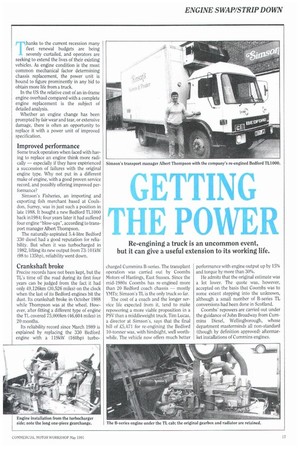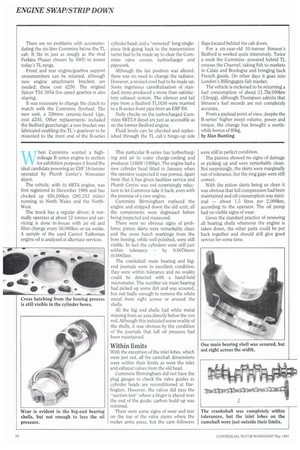GETTIN tir
Page 101

Page 102

If you've noticed an error in this article please click here to report it so we can fix it.
E POWER
Re-engining a truck is an uncommon event, but it can give a useful extension to its working life.
Thanks to the current recession many fleet renewal budgets are being severely curtailed, and operators are seeking to extend the lives of their existing vehicles, As engine condition is the most common mechanical factor determining chassis replacement, the power unit is bound to figure prominently in any bid to obtain more life from a truck.
In the US the relative cost of an in-frame engine overhaul compared with a complete engine replacement is the subject of detailed analysis.
Whether an engine change has been prompted by fair wear and tear, or extensive damage, there is often an opportunity to replace it with a power unit of improved specification.
Improved performance
Some truck operators when faced with having to replace an engine think more radically — especially if they have exorienced a succession of failures with the original engine type. Why not put in a different make of engine, with a good proven service record, and possibly offering improved performance?
Simson's Fisheries, an importing and exporting fish merchant based at Coulsdon, Surrey, was in just such a position in late 1988. It bought a new Bedford TL1000 back in1984; four years later it had suffered four engine "blow-ups", according to transport manager Albert Thompson.
The naturally-aspirated 5.4-litre Bedford 330 diesel had a good reputation for reliability. But when it was turbocharged in 1982, lifting its new output from 73-101kW (98 to 135hp), reliability went down.
Crankshaft broke
Precise records have not been kept, but the TL's time off the road during its first. four years can be judged from the fact it had only 49,126km (30,526 miles) on the clock when the last of its Bedford engines bit the dust. Its crankshaft broke in October 1988 while Thompson was at the wheel. However, after fitting a different type of engine the IL covered 75,000km (46,604 miles) in 20 months.
Its reliability record since March 1989 is explained by replacing the 330 Bedford engine with a 119kW (160hp) turbo charged Cummins B-series. The transplant operation was carried out by Coombs Motors of Hastings, East Sussex. Since the mid-1980s Coombs has re-engined more than 20 Bedford coach chassis — mostly YMTs; Simson's TL is the only truck so far.
The cost of a coach and the longer service life expected from it, tend to make repowering a more viable proposition in a PSV than a middleweight truck. Tim Lucas, a director at Simson's, says that the final bill of ,C5,471 for re-engining the Bedford 10-tonner was, with hindsight, well worthwhile. The vehicle now offers much better performance with engine output up by 15% and torque by more than 30%.
He admits that the original estimate was a lot lower. The quote was, however, accepted on the basis that Coombs was to some extent stepping into the unknown, although a small number of B-series TL conversions had been done in Scotland.
Coombs' repowers are carried out under the guidance of John Broadway from Cummins Diesel, Wellingborough, whose department masterminds all non-standard (though by definition approved) aftermarket installations of Cummins engines, There are no problems with accommodating the six-litre Cummins below the TL cab. It tits in just as snugly as the rival Perkins Phaser chosen by AWD to power today's TL range.
Front and rear engine/gearbox support crossmembers can be retained, although new engine attachment brackets are needed; these cost /250. The original Spicer T5A 3054 five-speed gearbox is also staying.
It was necessary to change the clutch to match with the Cummins flywheel. The new unit, a 330mm ceramic-faced Lipe, cost /245. Other replacements included the Bedford gearchange; a new bracket was fabricated enabling the TL's gearlever to be mounted to the front end of the B-series cylinder head; and a "rerouted" long singlepiece link going back to the transmission turret had to be made up to clear the Cummins valve covers, turbocharger and pipework.
Although the fan position was altered, there was no need to change the radiator. However, a revised cowl had to be made up. Some ingenious cannibalisation of standard items produced a more than satisfactory exhaust system. The silencer and tail pipe from a Bedford TL1630 were married to a B-series front pipe from an ERF E6.
Daily checks on the turbocharged Cummins 6BT5.9 diesel are just as accessible as on the former Bedford engine.
Fluid levels can be checked and replenished through the TL cab's hinge-up side flaps located behind the cab doors.
For a six-year-old 10-tonner Simson's Bedford is worked quite intensively. Twice a week the Cumminspowered hybrid TL crosses the Channel, taking fish to markets in Calais and Boulogne and bringing back French goods. On other days it goes into London's Billingsgate fish market.
The vehicle is reckoned to be returning a fuel consumption of about 21.71it/100km (13mpg), although Thompson admits that Simson's fuel records are not completely accurate.
From a payload point of view, despite the B-series' higher swept volume, power and torque, the change has brought a worthwhile bonus of 80kg.
by Alan Bunting












































































































